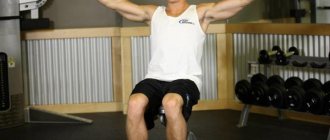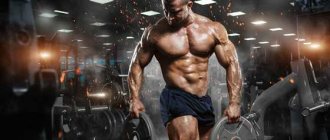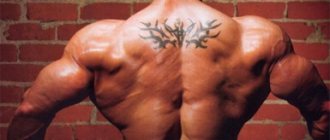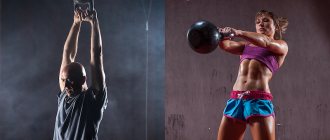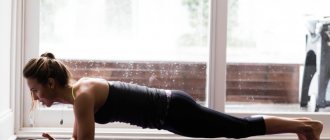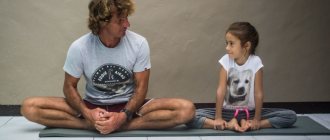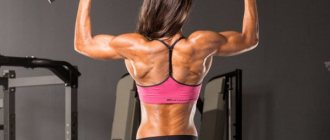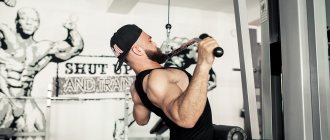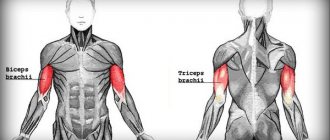Well-developed deltoid muscles are the key to a beautiful physique and broad, pumped-up shoulders, which many dream of getting. But not everyone takes into account three bundles of deltoid muscles at once when training. And this is a huge mistake.
Proper and even muscle building in all three parts of the shoulders gives them a three-dimensional, round and truly voluminous appearance. If you forget about one of them, all your work is in vain.
Don't believe me? Here are a couple of recent snapshots of my personal progress:
As you can see, it is the balanced development of the anterior, lateral and posterior deltoid muscles that gives my shoulder its complete appearance.
Shoulder structure
To better understand all this, let's look at the structure of the shoulders.
Like the triceps, the deltoid muscle is divided into 3 main parts. Anterior, lateral and posterior heads (bundle). They are also commonly referred to as the anterior, middle and posterior deltoids or deltoids.
All 3 bundles will work to one degree or another during the exercises. But each of them swings fully only when performing a certain type of movement.
In this article I will share the top shoulder workout, compiled and optimized based on:
- The most current scientific literature.
- Anatomical structure of the shoulder muscles.
But before we do that, let's talk briefly about the front delts.
Bodymaster.ru recommends Training Plans:
Often the deltoids are trained after larger muscles such as the back or chest. This means that all the energy will be directed to the first group, and nothing will be left on the shoulders. To stimulate growth, a high level of intensity and concentration is required.
The ideal option is to pump up the deltoid muscles on a separate day. This way the intensity will remain high and you will be able to lift more weight. The muscles will be fresh and easily respond to the impact.
Training the deltas in this program allows you to work on the trapezius. They don't require a lot of work, and the various variations of shrug exercises won't tire out your muscles. It is better to work on trapezius after deltoids.
Alternatively, the deltoids can be trained together with the quads and calves. This is a good option - the shoulder muscles will not get tired from working on the legs.
Why don't my deltoid muscles grow? (How to fix it?)
Are you often looking for ways to pump up your shoulders, but there are no results yet? I can congratulate you, you have come across the right article and will be able to solve this issue. Here I will clearly demonstrate how to properly pump and quickly build up the deltoid muscles in order to ultimately get bigger and stronger shoulders.
For many, the deltoids are an extremely difficult muscle group to train. It is worth noting that for most athletes it is not difficult to work the front delts, but when it comes to the lateral delts, this is where the difficulties begin. The lateral delts are precisely the muscles that demonstrate our texture and determine the width of the shoulders, which many strive to increase in volume.
But in practice, working out the side delts is not so difficult. Dumbbell lateral raises are generally the most effective way to achieve great results. And in fact, perhaps many of you who are reading this article perform similar exercises in everyday life, often without noticing it.
But then why don’t you see muscle growth in your shoulders? And you constantly wonder: how to pump up deltoids? So, in fact, it all depends on how correctly you perform the exercises, which at first glance are very simple.
Incorrect technique for performing dumbbell flyes
It's actually very rare to see gym goers actually perform this exercise properly. Instead of pumping specifically the lateral delts, they actually and unconsciously train other muscle groups. This occurs because athletes put unnecessary tension into their movements, swaying from side to side, back and forth while performing the required movements.
The upper trapezius muscles take on some of the work and relieve the load on the deltoids
In addition to this, one of the lesser known causes that we are not even aware of is the upper trapezius muscles. There are many reasons why they take most of the load from the deltoid muscles during exercise. Here are the most important reasons:
- Anatomical features of the upper trapezius muscle.
- A hyperactive state of this muscle group, due to a person being in a hunched position for a long time during the day.
For clarity, you can look at the photo below. This shows how the upper trapezius muscles work, and they are the ones that lift the shoulder. At that time, it can be seen that the deltoids are designed to raise the arms to the sides.
So, many of us who will perform raises with dumbbells will also involve our shoulders in the work, so that it is simply easier. This usually happens at the very beginning and at the end of performing a certain number of repetitions of a given exercise.
When you move dumbbells from point A to point B, the side delts lose their engagement at the end of the set. The amplitude is reduced and the movements become incorrect.
How to Minimize Upper Trapezius Muscle Involvement
The problem is also that many people make this mistake on a subconscious level. In practice, it turns out that over time, a familiar mechanism of action is developed and, when we spread our arms to the side, it is the upper trapezius muscles that are activated, not the deltoids.
Of course the trapezius muscles will always be involved to some extent, but they should not be the main ones. And since our main goal is precisely pumping up the deltoid muscles, creating strong and large shoulders, it is necessary to minimize the involvement of the upper trapezius muscles in the training process.
So, how to train correctly.
Contraindications to classes
Exercises for the middle delta of the shoulder are part of the training process for all girls who want to have a slim figure and an aesthetically attractive body.
Exercises to develop this part of the muscular system are contraindicated if you have the following health problems:
- diabetes;
- hypertonic disease;
- cardiac diseases;
- thrombophlebitis;
- phlebeurysm;
- intervertebral hernia;
- infectious processes occurring in acute or chronic form (a pathological condition of this type creates a focus of constant inflammation, which depletes the vital forces of the body);
- deficiency of vitamins and minerals;
- diseases of the digestive tract associated with impaired absorption of nutrients;
- recent cerebral stroke or myocardial infarction;
- severe fracture of the clavicle, accompanied by displacement of bone tissue;
- osteoporosis;
- immunodeficiency states of the body;
- previous spinal injuries that preclude the use of physical activity using sports equipment;
- inguinal hernia;
- oncological neoplasms, regardless of their location;
- inflammatory processes occurring in the structure of the elbow or shoulder joint;
- aortic aneurysm.
Exercises on the middle delta of the shoulder are contraindicated for girls who are pregnant or breastfeeding a newborn baby. During menstruation, it is also recommended to refrain from this type of physical activity.
How to start shoulder training the right way
First of all, you need to learn how to perform a basic exercise. This exercise will help you quickly learn how to turn off the trapezius muscles when you do dumbbell raises to the sides.
Some questions will go away after watching the video:
The exercise must be performed in a sitting position. Hold a dumbbell (2kg to start) in one hand, or you can even try doing it without weights at first. Place your other hand on your upper trapezius muscle and begin to slowly lift the dumbbell at about a 45-degree angle in front of you. During the exercise, monitor the condition of the upper trapezius muscle. You need to make sure that she is in a relaxed state and does not tense up.
As soon as they begin to tense up, you need to return to the starting position and repeat it all over again. That's why when you lift a dumbbell, think about the following:
- As you lower your shoulder down, make sure that the upper trapezius muscle does not contract.
If you are standing, fix the band between your foot and the upper trapezius muscle, as in the photo below, this will help you feel how correctly you are performing the exercise. When you lift the dumbbell, the band will also rise, indicating that the muscle is tense.
The main goal of this exercise is to lift the dumbbell with full range of motion and keep your arm parallel to the floor without straining the upper trapezius muscle. Many of you, even using light weights, will only be able to do a quarter of the entire range of motion before the trapezius muscle is involved in the work. There's really nothing wrong with this, you just need to keep training. You should focus on performing this exercise correctly and soon everything will work out.
Continue training and gradually increase the working weight. Then you can move on to performing dumbbell raises to the side with both hands at the same time. And don’t forget about the tips described above.
A few additional tips
And while you're practicing, we've got some additional helpful tips and tricks you can experiment with a little:
- Imagine that a horizontal bar is installed at the level of your deltoids, which does not allow you to raise your shoulders above this limit. So, don’t let your shoulders rise above this mark, the so-called invisible barrier.
- Don't just think about how to lift the dumbbell. Instead, think about how you can lift the dumbbell further away from your body. This is the type of execution that will be most effective.
- And some general recommendations. Experiment by taking a dumbbell without using your thumb and lifting it to the level of your shoulder blade. By lifting the dumbbell in this way, you will work the deltoid muscles as much as possible.
You may notice that the less the upper trapezius muscles are involved in the training process, the more effectively the deltoids work. And as a result, the deltoid muscles will begin to get tired quickly. At the same time, the working weight may decrease, since now we are doing the exercise correctly, and this is much more difficult than it was before. Now the muscles that we wanted to work are tensed, and without the involvement of the upper trapezius muscles, which partially compensated for the load, the exercise becomes very effective. Start with light weights and gradually increase the load. Try to do the exercise correctly.
Sets and reps for pumping up delts
What volume of sets and reps do deltoids respond best to? The deltoids are a small muscle group, so there is no need for a large number of sets. The average option is suitable.
Optimally – 10 approaches per workout. It's not too much and eliminates the risk of overtraining, but you can still lift enough weight and maintain the intensity.
In addition, you will be able to recover better. Since the deltoids are small muscles, they get tired faster. Not many people can do 20 sets of delts without overtraining.
If you are weak in training, perform basic exercises at least 8 repetitions per set to stimulate muscle growth. The exception is isolating exercises, for example, swings - 10-12 repetitions will be optimal for them.
Options for lifting dumbbells to pump up your shoulders
Alternatively, you can try another version of the exercise. You can control the position of the body, the main thing is to minimize the participation of the upper trapezius muscle during training.
#1 – Using an Incline Bench
You can use an incline bench. To do this, you need to take the starting position, as seen in the photo, and begin to lift the dumbbells up at an angle of 45 degrees. An incline bench helps ensure proper and stable work of the deltoid muscles. In this way, the participation of the upper trapezius muscles is minimized and only the delta is worked. But don't think that everything is so simple and easy. Even a weight of 2-5 kg can seem quite serious if the exercise is performed correctly.
Lateral swings with a cable in a prone position
You can also try a side swing using a cable while lying down. As studies have shown, it is in this position that the load on the upper trapezius muscle is reduced and the deltoids are thus perfectly pumped. Here you do not overcome gravity, but concentrate specifically on the deltoid muscles. It is these conditions that are the best and most effective, since constant resistance from the tensioned cable is ensured throughout the entire amplitude of movement. But you should also not forget to concentrate your thoughts on exactly those muscles that you are working.
Execution technique
When performing exercises on the anterior deltoid, you should follow the following general rules and techniques:
- To reduce the load on the back, it is recommended to perform while sitting.
- In order for the maximum load to fall on the shoulders, namely the front deltoids, you cannot swing the body and perform movements by inertia.
- All exercises are performed as slowly as possible, concentrating on technique and sensations, without jerking. Still, the likelihood of a shoulder injury due to negligence is very high.
- Training for the front delts always begins with warming up the joints and repeating the exercise with light weight.
Do I need to isolate the front delts?
As I mentioned earlier, it is important to pump and engage all three parts of the shoulder. But keep in mind that the front deltoid is already quite active and receives a lot of load during various exercises, such as push-ups.
The anterior deltoid muscle is very active in exercises such as the bench press.
Moreover, the greater the level of inclination, the more load falls on the front bundle during the pressing movement. I'm sure most of the exercises in your plan target this muscle to some degree. Therefore, in this article, exercises have been selected that load the lateral and posterior head of the deltas to a greater extent. After all, it is these two components of the shoulder muscles that are most often neglected.
A comprehensive approach to shoulder training not only makes your shoulders look aesthetically pleasing, but also, as one study states, “strengthening the posterior head of the deltoid muscle is essential for maintaining shoulder joint integrity and reducing the likelihood of injury.”
That is why in this article we will pay enough attention to the lateral and posterior heads of the humerus.
Also keep in mind that the four muscles of the pleural girdle are quite important muscles that should not be neglected. Why? Because they help stabilize the shoulder. But more on that in another article.
Benefits and contraindications
What are the benefits of anterior deltoid exercises?
- They help to form strong shoulders, which visually makes the figure chiseled and athletic.
- The training is useful for both the shoulder girdle and the arms. The forearm and triceps muscles are also involved in the process.
- Developed shoulders are an advantage during bench presses from any position and pulling loads.
- The deltoid muscles significantly influence athletic performance.
- They strengthen the upper body and also participate in functional movements.
Contraindications for exercises on the anterior delts are:
- Shoulder girdle injuries. When to start training, what exercises to include and what working weight to choose is decided by the attending physician.
- Exacerbation of chronic diseases of the spine, which is accompanied by pain. The back and shoulders are inextricably linked. Therefore, when loading the shoulder girdle, it is impossible to avoid the load on the back. And this is fraught with, at a minimum, increased pain.
- Acute period of any respiratory diseases.
The best exercises for properly training the deltoid muscles
So, to achieve excellent results, I have prepared an action plan. First of all, you must consciously approach your training. Start with light weights and gradually increase the pace. Pay attention to the exercise options described above. When you understand that it is the deltoid muscles that are working, you can begin to perform the exercise in a standing position without additional equipment and without prompts. The main thing is that the upper trapezius muscles do not work in conjunction with the deltoids.
You can also experiment with the exercises mentioned above. The most important thing we want to avoid is performing exercises incorrectly when the upper trapezius muscles are involved. Start with light weight and gradually with experience everything will come.
Exercise 1: Overhead press (focus on front and side delts)
The overhead press is an important compound exercise when it comes to training your shoulders. This is due to the fact that with the help of this movement it is easy to influence the muscles with weight and use all the bundles of the deltoid muscle. I'll talk about several variations of this exercise. But note that they all primarily target the anterior deltoid with some involvement of the lateral and posterior head.
The standing press also targets the core and serratus anterior muscles.
Benefits of the Overhead Press
This exercise is considered the best for developing and loading the anterior deltoid muscle.
In fact, the barbell overhead press outperformed dumbbell curls by 41%. This will be the only exercise you need to include in your front delt training program.
As for which option is most effective, it’s up to you:
- Standing overhead press;
- Standing overhead dumbbell press;
- Seated barbell press;
- Seated dumbbell press.
Variations of Overhead Presses
It has been proven that, compared to any other exercise, the standing dumbbell press puts more stress on:
- front,
- Lateral,
- And the posterior deltoids.
Choosing the Overhead Press
Plenty of research shows that the dumbbell overhead press is the best option. But I think it’s better to give preference to barbell presses, especially if you need a lot of weight.
They are not far behind the standing dumbbell press in terms of overall shoulder activation. And they are superior to seated options, too.
This does not make other options any less effective. Moreover, it is worth periodically alternating the different types of presses described above.
For example, if standing presses no longer produce the desired results, feel free to move on to seated dumbbell presses. If you are tired of doing the same exercise for several months, it is also worth changing the variation. However, I would advise sticking with one variation for a long period of time before considering changing variations.
Exercise 2: Lateral Raises (focusing on the lateral deltoid)
This exercise is usually performed in the gym. I highly recommend it for developing side buns. It targets primarily the lateral deltoid muscle with moderate involvement of the other two heads and the upper trapezius muscles.
This exercise is the most effective for pumping up the middle deltoid compared to other common shoulder exercises.
It is very popular, and there are many variations of this exercise for men. Let's look at the form of the movement and how to maximize shoulder activation while minimizing stress on the shoulder joint.
How to do lateral raises correctly
The technique is simple, but there are pitfalls. When you lift weights from the sides of your body, the activation of each part of the deltoid depends on how much it is in a straight line of force opposite to gravity.
Without rotating the shoulder, you can see that the lateral deltoid as well as the anterior deltoid are in a straight line of force opposite to gravity. This means that they will be used to the maximum during lifting.
To rotate your shoulder inward, imagine that you are pouring water from a jug. This will remove the front bundle of the deltoid muscle from work and force the lateral deltoid to move in a straight line of force, receiving maximum load.
It is worth noting that this is a fairly dangerous position for the shoulder joint and can lead to wear and tear and damage to the shoulder in the long run.
To correct this, you need to straighten your shoulders and move them out to the sides.
But you may notice that the muscle on the direct line of force is the anterior deltoid. To solve this problem and place more emphasis on your middelt, you can use one of two options.
Side lift options
Option 1: Lean forward slightly so that your lateral deltoid is more on the line of force.
Option 2: Do the exercise on an incline bench, it's the same idea.
But in both cases, you need to make sure that you rotate your shoulder outward slightly.
Exercise 3: Reverse flyes on the machine (for the rear deltoid)
Now we're going to put more emphasis on the rear delts. As I mentioned earlier, pumping them is necessary for the symmetrical fullness and relief of the shoulder muscles and the proper functioning of all the muscles of the shoulder girdle. This exercise focuses on the posterior deltoid, but also works other secondary muscles.
Research has shown that reverse flyes engage the rear delts more than seated rows and high pulldowns. This means that incorporating them into your training regimen is essential for optimal rear delt development.
Which grip is most effective? A neutral grip, with the palms facing each other, produces higher activation of the posterior deltoid and infraspinatus than a pronated palm grip, with the shoulders turned inward and the palms facing down.
Why is that? Well, in addition to horizontal abduction, the posterior deltoid also functions to externally rotate the shoulder. Because a neutral grip involves more external rotation than a pronated palm grip, it causes greater activation of the rear deltoid muscles.
A pronated palm grip can overstretch the posterior deltoid and prevent it from developing adequate strength due to its length-tension relationship.
Grip Variations
Any of the variations have a chance of life, because it may turn out that one of these grips will be the most effective for you.
Exercise 4: Weight rows to the face from a prone position
This exercise is my favorite when it comes to completely isolating the rear delts. And I highly recommend you try it. Although this variation will target the same muscles as a traditional standing row, it will reduce the work of the upper trapezius muscles.
The upper trapezius muscles are most active during standing exercises as they work to maintain a certain position in space of all or part of the body.
Thus, performing the exercise while lying on the ground:
- Eliminates the effects of gravity and
- May reduce excessive activation of the upper trapezius muscles.
This is exactly what we need, because often we don’t even notice how we overload the unnecessary muscles. Let's say that overactive trapezius muscles tend to outperform the rear deltoids in many movements. Lying down will correct this.
The most effective exercises for the rear delts
Types of muscle fibers in the shoulders
In terms of fiber type, numerous studies have shown that the shoulders have approximately an equal 50/50 ratio between Type I and Type II muscle fibers.
It is widely believed that:
- Type I fiber growth is best stimulated by high repetitions with light weights.
- Type II fiber growth is best stimulated by low repetitions with heavy weights.
Some studies agree with this. However, others show that both types of fibers will grow regardless of the rep range used.
But I think the research is still leaning toward including a varied range of repetitions while taking into account the distribution of fiber types. Thus, I think that both high and low reps in your training will be the best option from a hypertrophy standpoint.
Basic mistakes
It is necessary to include exercises on the anterior delta of the shoulder in your training no more than once or twice a week. Compliance with technique is the key to successful and effective training. To prevent the process of gaining weight and creating an athletic figure from dragging on for years, common mistakes should be avoided. Let's look at what beliefs interfere with effective training and mislead novice athletes. This is necessary to avoid mistakes and achieve visible progress in the muscles of the shoulder girdle.
Mistake #1. Thinking that all overhead presses are no different. If you carefully studied the technique of exercises for the anterior deltas, you noticed that the load changes depending on the position of the elbows and hands. The entire shoulder girdle is included in the work.
Mistake #2. Back deflection during seated bench press. To handle heavy weights, athletes often ignore proper body positioning when lifting dumbbells or bench presses. This can lead to spinal injury and disc herniation.
Mistake No. 3. Relaxed position of the arms and elbows while raising and spreading the arms. This violation of the execution technique leads to a shift of the load from the front deltas to the triceps.
Mistake No. 4. Violation of the split structure. Chest, shoulder and triceps workouts are almost seamless. There is no need to separate them into different days. You shouldn’t do them one after another (for example, chest on Monday, deltoids on Tuesday, triceps on Wednesday). If you decide to share the load, give it a rest (2-3 days) so as not to overload the deltas.
Mistake #5 : Impaired range of motion. Often, athletes ignore the gradual increase in working weight and perform effective exercises for the anterior deltoids with too much weight. This advance does not allow you to follow the execution technique and changes the range of movements. All this leads to a complete load on the muscles.
Sample training program
Here's an example of a workout you can do using the basic exercises previously described. They can be swapped, new ones added, or divided into two if you train shoulder width more than once a week.
- Overhead press: 3-4 sets of 6-10 reps.
- Lateral raises: 4 sets total (2 sets of 6-10 reps, 2 sets of 12-15 reps).
- Reverse flyes : 4 sets total (2 sets of 6-10 reps, 2 sets of 12-15 reps).
- Weight rows to the face from a lying position: 2 sets of 8-12 reps.
- Weight rows to the face from a standing or kneeling position: 2 sets of 8-12 reps.
And finally
In general, you should understand that if you are struggling to build certain muscle groups, then most likely this is the result of a conscious and careful approach to the goal. There must be a step-by-step program that should lead to the desired result. Don’t forget about science, it is she who gives the right advice that you should listen to. You need to train not only all day long, but also do it correctly, accurately and with maximum efficiency, combining this with a correct and balanced diet, and also do not forget about the mandatory recovery after training.
Sources:
- builtwithscience.com/shoulder-workout-science/
- builtwithscience.com/how-to-build-shoulders/
When should we expect the effect?
The first positive results of training to develop the middle delta of the shoulder will be visible after 1-2 months. regular exercise in the gym. This is provided that the girl refuses to drink alcohol, smoke, and provides her body with high-quality and balanced nutrition.
The middle delta is a bundle of muscle tissue located on the outer side of the shoulder joint. This part of the musculature performs the functions of flexing and extending the arm, lifting the limb up and abducting it to the sides. Exercises for the middle delta of the shoulder are performed using exercise machines, dumbbells and a barbell.
Training this part of the muscle involves creating basic and isolating loads on the outer side of the shoulder girdle.
Pumping the middle delta of the shoulder is carried out independently or under the guidance of an instructor. During the week, it is recommended to perform 3 workouts, alternating with days of rest and recovery of the body, creating a moderate cardiological load.
How to eat to pump up your deltoids
Nutrition is an important part in building the body of your dreams, which means that while working on deltoids you should closely monitor your diet. Consume more complex carbohydrates (rice, buckwheat and other cereals) and protein-rich foods (meat, fish, eggs and cottage cheese). And sports nutrition will help your body pump up deltoid muscles and recover after training.
When training for a delt pumping program, remember that your body needs materials to build muscle. Healthy food and sports nutrition will help you achieve your ideal body faster!
Pumped delts look very impressive. Round and defined muscles will give you confidence. Follow the advice in this article and you will pump up deltas that will make you jealous!
How to pump up deltoids in a split
In most cases, deltas are not given enough attention. It can be difficult to dedicate a day exclusively to this muscle group. However, like other important muscle groups - legs, back, chest - the deltoids also require separate training.
If you decide to do split training, first familiarize yourself with its concept in order to correctly select exercises and determine the number of days. If you combine deltoids with other muscles, start training with deltoids. If you think that another muscle group is more important, then start with it.
If you combine pumping up the deltoids with your back, then it is advisable to start with the posterior part of the deltoid muscle (variation: you can start with the middle one). This is justified by the fact that if you hit your shoulders first, you won’t be able to fully load your back. Train the big muscles first, then the small ones. Below is a four-day split training program for advanced athletes.
One arm press variation
Most athletes are slightly asymmetrical, but in bodybuilding they strive for perfect forms. The one-arm seated press is a way to correct minor asymmetries. To perform it, you will need a hummer, a special simulator with a lever design, and not a simulator in which both handles are fixed. The press is performed either in a set alternately, that is, first the right hand presses, then the left, or first all approaches with the right, then with the left. The second option is considered more preferable if the athlete has significant asymmetry and cannot balance his strength indicators.
